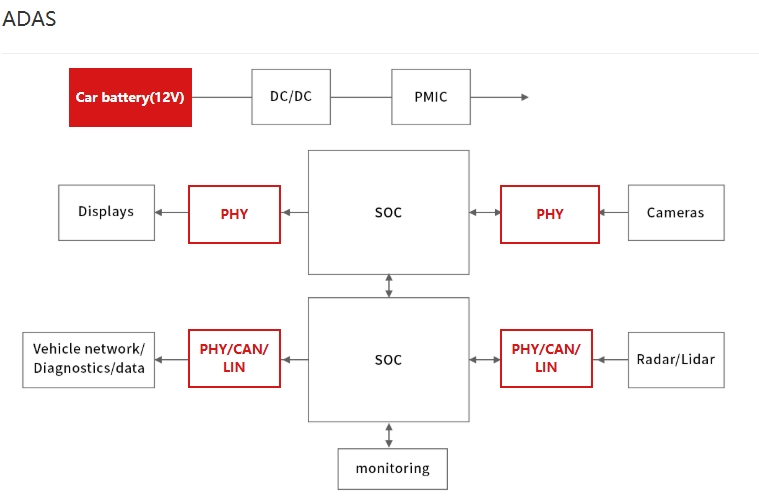Overview
For ADAS, "load dump" and "electrostatic discharge" (ESD) are two important concepts closely related to electrical safety and system immunity. They can cause potential damage to key systems such as electronic components, sensors, and ECUs (electronic control units), so they must be taken seriously and protected when designing ADAS systems.
About Load Dump
1.What is Load Dump?
Load dump means that when the car generator is charging the battery, if the battery is suddenly disconnected from the circuit (for example, the battery connection line is disconnected), due to the characteristics of inductance, the voltage output by the generator will increase instantly (may reach more than 100V), causing a great impact on the entire electrical system.
2.Hazards of Load Dumping
- Sudden voltage surges may damage ADAS controllers (such as camera control units, radar modules, main controllers, etc.).
- It may burn sensitive electronic components on PCB boards.
- It may cause system malfunctions or restarts.
3.Protective Measures
- Use transient voltage suppression diodes
- Power regulators with load dump protection
- Add LC filter circuits
- Use electronic components that comply with ISO 7637-2 standards
About Static Electricity
1.What is static electricity?
Static electricity is the accumulation of charge due to the aggregation of electrons, usually generated by contact between people, equipment or in dry air. When these charged bodies suddenly come into contact with electronic devices, high-voltage electrostatic discharge (ESD) will occur, causing damage to microelectronic devices.
2.What are the risks of static electricity to ADAS?
- Damage to sensitive components (such as CMOS cameras, LiDAR receivers)
- Cause sensor mis-triggering or communication failures
- Potential system stability risks
3.Protective Measures
- Add ESD protection diodes to the PCB layout
- Use metal shielding/grounding design on the housing and sensor exterior
- Use antistatic material to cover
- Tests follow standards such as IEC 61000-4-2
Application Circuit Diagram

Interface and Protection Solutions
1.12V Power Port
The load dump protection circuit of the 12V power port is mainly used to deal with the high voltage pulse (Load Dump) generated by the battery disconnection in the automotive power system. Its instantaneous voltage may reach 60V~100V, causing fatal damage to the back-end electronic equipment.
It is recommended to use TPSMCJ33CA automotive TVS diode, which meets the AEC-Q101 certification standard:
2.PHY Interface
PHY (Physical Layer Device) is a key module that connects digital controllers and physical media (such as Ethernet cables) in network communications. It is commonly used in ADAS and automotive Ethernet (such as 100BASE-T1, 1000BASE-T1). Since PHY chips are usually directly connected to the external interface of the vehicle (RJ45/connector), they are extremely susceptible to electrostatic discharge (ESD), so electrostatic protection design is very important.
It is recommended to use Semiware's TPSE3D35B3.3MA automotive electrostatic suppressor product, which meets the AEC-Q101 certification standard. It has the characteristics of low leakage current, fast response speed (nS level), and high reliability.
3.CAN Bus Interface
CAN bus is a widely used communication bus in automobiles and industrial systems. Electrostatic discharge (ESD) protection is critical because its physical layer is often exposed to the outside of the vehicle or the connector interface and is susceptible to static interference. Goals of CAN bus ESD protection:
- Resist electrostatic discharge (ESD) voltage (±8kV~±25kV)
- Resist surge and electrical fast transients (such as ISO 7637, ISO 10605)
- Do not affect CAN signal quality (do not add too much capacitance)
- Meet automotive standards (such as AEC-Q101, ISO 11898)
It is recommended to use TPSE23T20B24LB automotive ESD suppressor, which meets the AEC-Q101 certification standard. It has the characteristics of small leakage current, fast response speed (nS level), high reliability, etc., and is widely used in ESD protection of high-speed signal transmission interfaces such as HDMI, USB, VGA, etc. in automotive electronic equipment:
4.LIN Bus Interface
LIN bus (Local Interconnect Network) is commonly used in automobiles for low-speed, low-cost control module communication, such as window, electric seat, headlight control, etc. Although it operates at a lower frequency (20kbps), ESD protection is still very important due to its single-wire communication structure and exposure at the connector end. Goals of LIN bus ESD protection:
- Resist electrostatic discharge (±8kV contact / ±15~25kV air)
- Do not affect LIN signal integrity (low frequency but maintain logic level)
- Meet automotive regulations (AEC-Q101, ISO 10605)
- Compatible with LIN transceivers (such as TJA1021, ATA663211)
We recommend the PESD1LIN automotive electrostatic suppressor product, which complies with the AEC-Q101 certification standard:
For more information on circuit protection solutions and applications related to automotive headlight products, please visit:https://en.semiware.com/applications/adas/
About Semiware
Semiware has a comprehensive product lineup of circuit protection device products. The company leverages its technology in the semiconductor field and application background in end products to serve customers in the electronics, automotive and industrial markets. For more information, please visit semiware official website: https://en.semiware.com/


Comments (0)